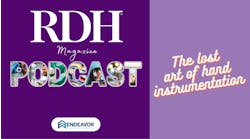By Karen Kaiser, RDH
Accidentally hitting a curb while driving may result in a flat tire. Hopefully your trunk contains the equipment necessary to fix a flat, including a lug nut wrench, car jack, and spare tire. Mini spares are colloquially referred to as “donuts.” They save on trunk space, and are narrower than other tires. They can be used only for a limited distance and at a low rate of speed. Spare tires are lightweight and temporary. Like a spare tire, temporaries in dentistry are to be used for a short time, while a more permanent restoration may be laboratory fabricated.
One may consider fabricating temporary restorations a task for the doctor or dental assistant, but making temporaries can also be delegated to a trained hygienist. Hygienists know the contours of the tooth well, and can skillfully adapt material at the gingival margin. The true definition of a team member is being willing and able to be cross-trained in order to lend a skilled hand to coworkers. With today’s modern materials, provisionals may be less of a chore than previously thought.
No Time to Spare
Temporization materials may produce a setting reaction that gives off heat during polymerization. This may be uncomfortable for the patient during the fitting process. Patients better accept materials that heat to about body temperature and avoid a heat spike. Materials are for the most part fast setting. A working knowledge of temporary materials as well as the correct set times is important. It’s important to keep this time factor in mind and remove the temporary from the prepped tooth prior to the full polymerization, or it may become lodged on the tooth and require force to remove. Fortunately, materials have an elastic phase which allows the temporary to be removed before it distorts. When the temporary is removed from the tooth easily and not distorted, better contacts remain intact and alleviate the need to remarginate.
Whether delivered by a handheld syringe or a dispensing gun, temporary materials are user friendly, and delivering them by a syringe is not as difficult as it appears. Many temporary materials are available in a syringe gun delivery. Luxatemp by Zenith/DMG is popular for cartridge systems because it has fluorescence and releases fluoride. Cartridges are preloaded and mixed together as a catalyst and base, and then dispensed through the mixing tip to eliminate mess, as they create a homogenous material using a two component cartridge material dispensed by a cartridge/static mixing tip combination. On the dispenser, a lock and lever system with a slide is inserted into the seated cartridge, aligned, and clicked to extrude material. Selecting and securely seating the correct tip is crucial. Also, temporary materials have universal or specific tips, which may only fit certain products. Dentsply Caulk has the Integrity material that is available in two tips for mixing. One tip is 50 percent smaller and reduces waste when used for single unit provisionals.
Handheld unit dose delivery is also popular for temporary fabrication. This self-contained system gives a consistent mix that alleviates air bubbles. Handheld dispensing from these syringes is economical because there is less potential for material to be wasted. Composition of the syringe material is lifelike and offers improved esthetics and many shades. When the material is highly polished, there will be less irritation at the tissue margins from a rough temporary. Fill-In Unidose by Kerr is a two-component syringe that fits easily into the hand for smooth dispensing. There are no additional cartridges or need to inventory an extruder gun, since a disposable syringe is used once and thrown away.
3M ESPE has a temporization material called Protemp that is simple to use. It is a single unit, malleable material that comes with the anatomy pre-formed. When using this material there is no impression or any matrix needed. The clinician selects the appropriate size by using the size guide, and lifts off the top of the sealed container to reveal the preformed temp. This type of temporary is ideal for single unit crowns. The natural looking temp is simply trimmed and adapted to the tooth preparation, and the warmth of the fingers allows the material to become even suppler. The temporary is tacked and fully cured with a light. It is an excellent choice when temporaries are dislodged from the prep or lost or worn down by the stress of chewing.
It is important to remove all excess cement from the temporary restoration. Leaving residual cement will irritate tissues and impede the healing process from the crown and bridge procedure. Hygienists are fully capable of thoroughly removing restorative cements before the patient leaves.
Though hygienists are usually not asked to make temporary provisionals, possessing the necessary skills is as valuable as having the skills to change a flat tire. Perhaps the office is tightly scheduled, and the hygienist can help alleviate the workload and help the restorative side if he/she is cross-trained. Even though there may be many different materials used on the restorative side for provisional, knowing the basics of temporization materials and fabrication is fundamental.
The author did not receive compensation for products mentioned. For more permanent ideas, visit the Web at www.caulk.com, www.zenithdmg.com, www.kerrdental.com, or www.3MESPE.com
About the Author
Karen Kaiser, RDH, graduated from St. Louis’ Forest Park dental hygiene program in 1994 and currently practices at the Center for Contemporary Dentistry in Columbia, Ill. She has written several articles for RDH and other publications, sits on dental hygiene panels, and is an evaluator for Clinical Research Associates. She can be contacted at [email protected].







